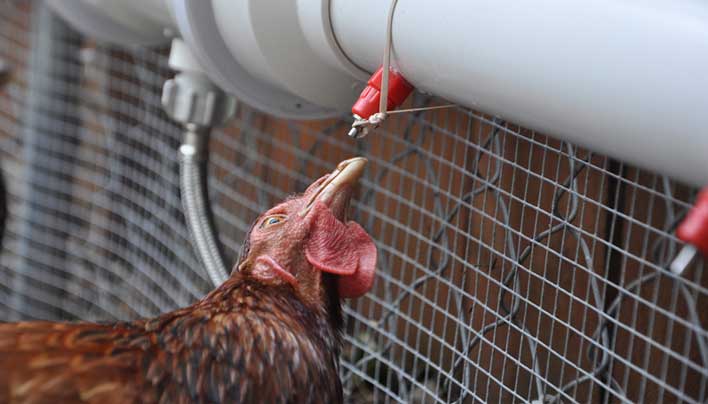By P. Henry
When we got our chickens back in March I was looking forward to so many things about having them in our yard. From the eggs we would be eating to the benefits of having them scrounge through our garden to the simple things like hearing them cluck as they scratched around their pen. Having Chickens brings a whole wealth of advantages to just about anyone and they are for the most part ridiculously easy to care for.
As we were building the pen and purchasing the additional supplies needed, the subject of water came into focus. Chickens are very simple to care for and for my part only require that they be let out and put up each day (to keep predators from killing them while they sleep), food and water. I thought that if I could just figure out a way to automatically feed them, let them out and water them, they would be almost zero maintenance! Now, I am not saying I want to sit in my house all day and not have to worry about the animals, but having a system would make simple weekend trips away from home much easier. As it stands now, we have to get someone to watch them while we are gone.
Each morning I wake up and let my chickens out of their coop, give them fresh food and water. The food part is simple as I have a closed container with their pellets right out by the coop so I just give them a scoop of fresh pellets in their feeder. Water requires taking their water container and walking back to the house to rinse and refill. You have to do this every day because chickens need fresh, clean water to prevent them from getting sick. Left to their own devices though, chickens will not keep their water fresh and clean. They will scratch dirt into there; poop and pretty much do everything they can to make that water nasty.
Now, walking back to my house isn’t a chore, but it does seem like a waste of time and energy. I usually throw a lot of good water away just refilling and cleaning the container so I have been looking for an alternative and recently found what I think is an amazingly simple solution for watering my chickens that keeps the water clean and cuts down on my trips in and out of their coop. I didn’t have to look too long though because this is an issue that apparently every single other person who raises chickens has already complained about. There are tons of videos on YouTube and you can even buy pre-built kits, but this is a easy DIY project that anyone can do in a couple hours tops.
When finished your waterer will look similar to this.
The concept is brilliantly simple. First you need a bucket to store your water in. This will be your reservoir and I am going to use a five gallon bucket. When filled, the bucket will weigh about 40 pounds so you need to carefully plan on how you are going to mount your bucket. Right now, I am going to mount my bucket with a sturdy bracket screwed right into the frame on our chicken coop on the outside of the building. This way, I can refill the bucket easily without having to go into the pen. The bucket holds the water which is fed via a hose to a PVC tube in the chicken’s pen. The tube has small nipples that you can buy from Amazon that allow the chickens to drink whenever they need to, but they aren’t able to pollute the water. Genius.
Why did it take me so long to figure this out? I don’t know but I am glad I did. You can build your own set up using the parts list below and you will get something that looks very similar to the image on the right. There is also a video below that shows the principles of the design, but not exactly the same execution. The parts list allows for a tube running from the reservoir to the tube as opposed to having the tube directly connected to the reservoir.
Pipe Waterer Supply List
- Length of ¾ inch PVC pipe
- One ¾ inch slip-fit by ½ inch FPT (female pipe thread) PVC Elbow
- One ¾ inch slip fit PVC cap
- Two ½ inch MIP (Male Iron Pipe) by 3/8-inch barb connectors
- One package 3/8-inch inside diameter tubing (use black to prevent algae growth)
- One ½ inch FPT Bulkhead union (typically sold for rain barrel systems)
- PVC Primer and PVC cement
- Bucket or other water reservoir
- Drill bits in appropriate sizes (11/32 for predrilled nipple holes and 1 and ¼ inch bit for the bulkhead union hole)
- Teflon tape
- Silicone sealant
Filed under: How To Prepare, Outdoor Recreation, Prepping

